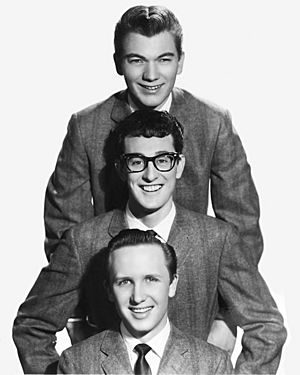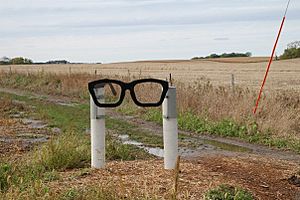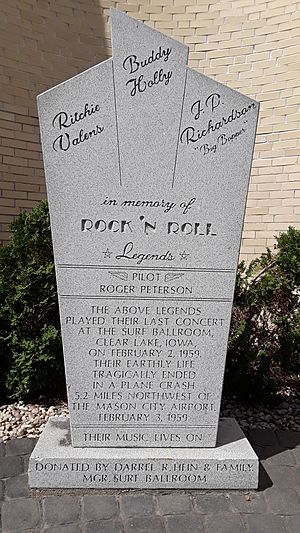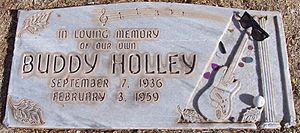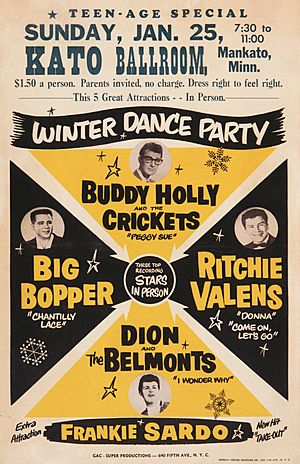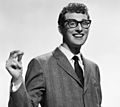Buddy Holly facts for kids
Quick facts for kids
Buddy Holly
|
|
|---|---|
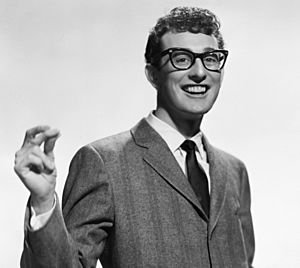
Holly in 1957
|
|
| Born |
Charles Hardin Holley
September 7, 1936 Lubbock, Texas, U.S.
|
| Died | February 3, 1959 (aged 22) Clear Lake, Iowa, U.S.
|
| Cause of death | Blunt trauma as a result of a plane crash |
| Resting place | City of Lubbock Cemetery in Lubbock County, Texas |
| Occupation |
|
| Years active | 1952–1959 |
| Spouse(s) |
María Elena Santiago
(m. 1958) |
| Musical career | |
| Genres | |
| Instruments |
|
| Labels |
|
| Associated acts |
|
Charles Hardin Holley (born September 7, 1936 – died February 3, 1959), known as Buddy Holly, was an American singer and songwriter. He was a very important and early figure in rock and roll music during the mid-1950s. Buddy grew up in a musical family in Lubbock, Texas, during the Great Depression. He learned to play guitar and sing with his brothers and sisters. His music was a mix of gospel music, country music, and rhythm and blues. He performed these styles in Lubbock with his high school friends.
Buddy first appeared on local television in 1952. The next year, he formed a group called "Buddy and Bob" with his friend Bob Montgomery. In 1955, after performing before Elvis Presley, Buddy decided to make music his full-time career. He opened for Presley three times that year. His band's music changed from country to pure rock and roll. In October 1955, when he opened for Bill Haley & His Comets, a talent scout named Eddie Crandall saw him. Crandall helped Buddy get a record deal with Decca Records.
Buddy was not happy with how his songs were produced at Decca. He then worked with producer Norman Petty in Clovis, New Mexico. There, he recorded a demo of "That'll Be the Day" and other songs. Petty became the band's manager. He sent the demo to Brunswick Records, which released it as a single. The song was credited to "The Crickets", which became the name of Buddy's band. In September 1957, "That'll Be the Day" became a number one hit in the US and UK. This success was followed in October by another big hit, "Peggy Sue".
The album The "Chirping" Crickets came out in November 1957 and reached number five on the UK Albums Chart. Buddy appeared on The Ed Sullivan Show again in January 1958. Soon after, he toured Australia and then the UK. In early 1959, he put together a new band. It included future country star Waylon Jennings (bass), famous musician Tommy Allsup (guitar), and Carl Bunch (drums). They started a tour across the midwestern US. After a show in Clear Lake, Iowa, Buddy hired a small airplane to fly to his next show in Moorhead, Minnesota. Soon after taking off, the plane crashed. Buddy, Ritchie Valens, The Big Bopper, and pilot Roger Peterson all died. This sad event was later called "The Day the Music Died" in Don McLean's song "American Pie".
Even though his career was short, Buddy Holly wrote and recorded many songs. He is often seen as the artist who set the standard for rock-and-roll bands: two guitars, bass, and drums. He greatly influenced many later popular music artists, including Bob Dylan, The Beatles, The Rolling Stones, Eric Clapton, The Hollies, Elvis Costello, and Elton John. He was one of the first artists to be inducted into the Rock and Roll Hall of Fame in 1986. Rolling Stone magazine ranked him number 13 on its list of "100 Greatest Artists" in 2010.
Contents
Buddy Holly's Early Life and Music Career
Growing Up and Finding Music (1936–1955)
Buddy Holly was born Charles Hardin Holley on September 7, 1936, in Lubbock, Texas. He was the fourth child of Lawrence Odell "L.O." Holley and Ella Pauline Drake. His family had a strong interest in music. Everyone except his dad could play an instrument or sing. When he was young, Buddy was nicknamed "Buddy."
At age 11, Buddy took piano lessons but stopped after nine months. He switched to the guitar after seeing a classmate play on the school bus. His parents bought him a guitar, and his brother Travis taught him how to play. As a child, Buddy was influenced by country music artists like Hank Williams and Jimmie Rodgers.
In elementary school, Buddy became friends with Bob Montgomery. They played music together, practicing songs by groups like the Louvin Brothers. Buddy also played with other musicians he met in high school, including Sonny Curtis and Jerry Allison. In 1952, Buddy and Jack Neal performed as a duo on a local TV talent show. After Neal left, Bob Montgomery joined, and they became "Buddy and Bob." They started performing on the Sunday Party radio show in 1953 and played live gigs in Lubbock. Buddy also listened to late-night radio stations that played blues and rhythm and blues (R&B). He began mixing his country music style with R&B.
By 1955, after finishing high school, Buddy decided to become a full-time musician. He was inspired after seeing Elvis Presley perform live in Lubbock. Buddy opened for Presley three times that year. By then, his band included Larry Welborn on bass and Jerry Allison on drums. Their style changed from country to rock and roll because of Presley's performances. In October, a scout from Nashville saw Buddy perform. This led to Buddy signing a record deal with Decca Records in February 1956. In the contract, Decca accidentally misspelled his last name as "Holly" instead of "Holley." From then on, he was known as "Buddy Holly."
Buddy recorded several songs with Decca, but he felt he didn't have enough control over his music. In April 1956, Decca released his first single, "Blue Days, Black Nights." Neither of his first two singles became hits. On January 22, 1957, Decca told Buddy they would not renew his contract.
Forming The Crickets (1956–1957)
Buddy was unhappy with his time at Decca. He was inspired by the success of other artists and visited Norman Petty, a producer. Buddy, along with Jerry Allison, bassist Joe B. Mauldin, and rhythm guitarist Niki Sullivan, went to Petty's studio in Clovis, New Mexico. They recorded a demo of "That'll Be the Day," a song they had recorded before. This time, Buddy played lead guitar and got the sound he wanted.
Petty became Buddy's manager and sent the recording to Brunswick Records in New York City. Since Buddy was still under contract with Decca, he couldn't release the song under his own name. So, they used a band name. Allison suggested "Crickets." Brunswick liked the demo so much that they released it without recording a new version. "I'm Looking for Someone to Love" was the B-side, and the single was credited to The Crickets.
Later, Buddy and Petty learned that Brunswick was part of Decca. This meant Buddy could legally release future songs under his own name. Songs credited to The Crickets would be released on Brunswick, while songs under Buddy's name would be released on another label called Coral Records. Buddy had recording contracts with both labels at the same time.
"That'll Be the Day" was released on May 27, 1957. Petty booked Buddy and The Crickets for a tour. The band played at New York's Apollo Theater. At first, the audience wasn't impressed, but they loved the band after they played "Bo Diddley." By the end of their shows at the Apollo, "That'll Be the Day" was climbing the music charts.
"That'll Be the Day" became number one in the US on September 23 and stayed number one in the UK for three weeks in November. On September 20, Coral released "Peggy Sue," with "Everyday" on the other side, credited to Buddy Holly. By October, "Peggy Sue" reached number three on Billboard's pop chart. As the song became more popular, Buddy got more attention. The band was often called "Buddy Holly and the Crickets."
The album, The "Chirping" Crickets, was released on November 27, 1957. It reached number five on the UK Albums Chart. In October, Brunswick released the second single by The Crickets, "Oh, Boy!" with "Not Fade Away" on the B-side. This single reached number 10 on the pop chart. Buddy and The Crickets performed "That'll Be the Day" and "Peggy Sue" on The Ed Sullivan Show on December 1, 1957. After this, Niki Sullivan left the group because he was tired of touring and wanted to go back to school.
World Tours and Changes (1958)
On January 8, 1958, Buddy and The Crickets joined the America's Greatest Teenage Recording Stars tour. On January 25, Buddy recorded "Rave On." The next day, he appeared on The Ed Sullivan Show again, singing "Oh, Boy!" He then went to Honolulu, Hawaii, and started a week-long tour of Australia with other stars like Paul Anka. In March, the band toured the United Kingdom, playing 50 shows in 25 days. That same month, his first solo album, Buddy Holly, was released.
When they returned to the United States, Buddy and The Crickets joined another big tour. In April, Decca released That'll Be the Day, which featured songs he recorded earlier in Nashville.
In May, Buddy arranged a new recording session in Clovis. He hired Tommy Allsup to play lead guitar. They recorded "It's So Easy" and "Heartbeat." Buddy was impressed by Allsup and asked him to join The Crickets. In June, Buddy went to New York alone for a solo recording session. Without The Crickets, he chose to be backed by a jazz and R&B band.
During a visit to a music office, Buddy met María Elena Santiago. He asked her out on their first meeting and proposed marriage to her on their first date! They got married on August 15. Buddy's manager, Norman Petty, didn't approve of the marriage and told Buddy to keep it a secret so his female fans wouldn't be upset. This caused problems between Buddy and Petty. Buddy also started to wonder about Petty's money management. The Crickets were also unhappy with Petty, who controlled all the money the band earned.
Buddy and María Elena went to many music places in New York. María Elena said Buddy wanted to learn flamenco guitar. Buddy also planned to work with soul singers and rock and roll artists. He wanted to make an album with Ray Charles and Mahalia Jackson. He also wanted to act in movies and took acting classes.
María Elena went with Buddy on tours. To keep their marriage a secret, she pretended to be the Crickets' secretary. She helped with laundry and setting up equipment. She also collected the money from the concerts. She kept the money for the band instead of sending it to Petty in New Mexico. María Elena and her aunt convinced Buddy that Petty was putting the band's earnings into his own company's account. Buddy planned to get his money back from Petty and then fire him as his manager.
In September, Buddy returned to Clovis for new recordings, including "Reminiscing." During this time, he also started producing music for other artists, like Lubbock DJ Waylon Jennings. Buddy became more interested in the music scene in New York. He and María Elena moved to an apartment in Greenwich Village, New York. There, he recorded several acoustic songs, like "Crying, Waiting, Hoping."
On October 21, 1958, Buddy had his last studio recording session. He recorded four songs with the Dick Jacobs Orchestra, a large 18-piece group. These songs were:
- "True Love Ways" (written by Buddy Holly)
- "Moondreams" (written by Norman Petty)
- "Raining in My Heart" (written by Felice and Boudleaux Bryant)
- "It Doesn't Matter Anymore" (written by Paul Anka)
Buddy ended his partnership with Norman Petty in December 1958. His band members decided to keep Petty as their manager and split from Buddy. The split was friendly. Buddy wanted to live in New York, where the music business was, and The Crickets preferred to stay in Texas. Since Petty was still holding the money from Buddy's earnings, Buddy had to form a new band and go back on tour.
The Winter Dance Party Tour and His Death (1959)
Buddy spent time with his wife in Lubbock and visited Waylon Jennings's radio station in December 1958. For the start of the Winter Dance Party tour, he put together a new band. It included Waylon Jennings (electric bass), Tommy Allsup (guitar), and Carl Bunch (drums).
The Winter Dance Party tour began in Milwaukee, Wisconsin, on January 23, 1959. The tour involved a lot of travel, and the distances between shows were very long. The unheated tour buses broke down twice in freezing weather. Buddy's drummer, Carl Bunch, had to go to the hospital for frostbite on his toes. Because of these problems, Buddy decided to find other transportation.
On February 2, before their show in Clear Lake, Iowa, Buddy hired a small, four-seat airplane. He planned to fly with Jennings and Allsup to their next show in Moorhead, Minnesota. This would give them time to rest and wash their clothes, avoiding another difficult bus trip. After the Clear Lake show, which ended just before midnight, Allsup agreed to flip a coin with Ritchie Valens for a seat on the plane. Valens won the coin toss. Waylon Jennings gave up his seat to J. P. Richardson (the Big Bopper), who had the flu and found the bus too cold.
The pilot, Roger Peterson, took off in bad weather. Shortly after 12:55 AM on February 3, 1959, the plane crashed into a cornfield five miles northwest of Mason City. Buddy Holly, Ritchie Valens, J. P. Richardson, and pilot Roger Peterson were all killed. Buddy was only 22 years old.
Buddy's funeral was held on February 7, 1959, in Lubbock. His body was buried in the City of Lubbock Cemetery. His headstone has the correct spelling of his last name (Holley) and a carving of his Fender Stratocaster guitar.
María Elena Santiago watched the news of Buddy's death on television. The next day, she suffered a miscarriage. Buddy's mother, who heard the news on the radio, screamed and collapsed. Because of María Elena's miscarriage, authorities later made a rule not to announce victims' names until their families are told. María Elena did not go to the funeral and has never visited his grave. She later said, "In a way, I blame myself. I was not feeling well when he left. I was two weeks pregnant, and I wanted Buddy to stay with me, but he had scheduled that tour. It was the only time I wasn't with him. And I blame myself because I know that, if only I had gone along, Buddy never would have gotten into that airplane."
Buddy Holly's Style and Legacy
His Unique Look and Sound
Buddy Holly's singing style was special. He used "vocal hiccups" and switched between his normal voice and a high-pitched falsetto. His unique vocals were matched by his percussive guitar playing, cool solos, and rhythm and blues chord progressions. He often strummed his guitar with strong downstrokes, along with Allison's "driving" drum beats.
Buddy bought his first Fender Stratocaster guitar, which became his signature instrument, for $249.50. He chose it because of its loud sound. His "innovative" playing style mixed "chunky rhythm" and "high string lead work." He owned four or five Stratocasters during his career.
When they first started, Buddy and his band wore business suits. Later, they were advised to try Ivy League clothes. Buddy was also told to replace his old-fashioned glasses with horn-rimmed glasses, which were popular at the time. Buddy bought a pair of these glasses. Teenagers in the United States started asking for this style of glasses, which became known as "Buddy Holly glasses."
After the plane crash, Buddy's signature glasses were thought to be lost. But in March 1980, they were found in a storage area. They had been found in the spring of 1959 after the snow melted and given to the sheriff's office. The glasses, missing their lenses, were returned to María Elena a year later. They are now on display at the Buddy Holly Center in Lubbock, Texas.
His Lasting Influence on Music
Buddy Holly left behind many unfinished recordings. These included solo recordings of his new songs, jam sessions with bandmates, and tapes of songs meant for other artists. The last known recordings were made in his apartment in late 1958.
The demand for Buddy Holly's music was so great that his record label released new albums and singles for the next 10 years. Norman Petty produced most of these new releases, using unreleased studio recordings and even amateur tapes. The final "new" Buddy Holly album, Giant, was released in 1969.
Encyclopædia Britannica said that Buddy Holly "produced some of the most distinctive and influential work in rock music." AllMusic called him "the single most influential creative force in early rock and roll." Rolling Stone ranked him number 13 on its list of "100 Greatest Artists." The Telegraph called him a "pioneer and a revolutionary." In 2023, Rolling Stone ranked Holly at number 174 on its list of the 200 Greatest Singers of All Time.
The Rock and Roll Hall of Fame inducted Buddy Holly in its first group of honorees in 1986. They noted how much music he created in his short career and said it "made a major and lasting impact on popular music." They called him an "innovator" for writing his own songs, experimenting with double tracking (recording a part twice to make it sound fuller), and using orchestration (adding instruments like strings). He also "pioneered and popularized the now-standard" use of two guitars, bass, and drums for rock bands. The The Songwriters Hall of Fame also inducted Holly in 1986, saying his contributions "changed the face of Rock 'n' Roll."
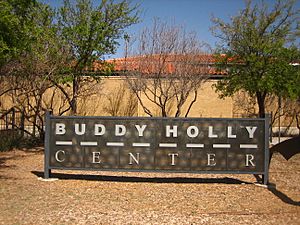
In 1980, a statue of Buddy Holly playing his Fender guitar was created. This statue is the main feature of Lubbock's Walk of Fame, which honors important people from Lubbock's music history. Other memorials to Buddy Holly include a street named after him and the Buddy Holly Center. This center has a museum with Buddy Holly items and an art gallery.
In 1997, the National Academy of Recording Arts and Sciences gave Buddy Holly the Grammy Lifetime Achievement Award. Holly was inducted into the Iowa Rock 'n' Roll Hall of Fame in 2000. On May 9, 2011, the City of Lubbock opened the Buddy and Maria Elena Holly Plaza, the new home for his statue and the Walk of Fame. That same year, a star with Buddy's name was placed on the Hollywood Walk of Fame to celebrate his 75th birthday.
A new performing arts center in Lubbock, the Buddy Holly Hall of Performing Arts and Sciences, began construction in 2017. This large project is expected to be completed in 2020.
How Buddy Holly Influenced Other Artists
John Lennon and Paul McCartney of The Beatles first saw Buddy Holly perform on TV. They had just met and started making music together. They studied Holly's songs and performance style. Inspired by Holly's band, The Crickets (an insect), they chose to name their band "The Beatles" (also an insect-related name). Lennon and McCartney often said Buddy Holly was one of their biggest influences.
Lennon's first band, the Quarrymen, covered "That'll Be the Day" in 1958. During breaks in The Beatles' first appearance on The Ed Sullivan Show in 1964, Lennon asked about Holly's performances. The Beatles recorded a cover of Holly's version of "Words of Love" for their 1964 album Beatles for Sale. Lennon also recorded a cover of "Peggy Sue" on his 1975 album Rock 'n' Roll. Paul McCartney now owns the publishing rights to Buddy Holly's songs.
On January 31, 1959, two nights before Buddy's death, 17-year-old Bob Dylan saw Holly perform in Duluth. Dylan mentioned this in his speech when he won a Grammy Award in 1998. He said he was three feet away from Buddy and felt like Buddy was "with us all the time we were making this record."
Mick Jagger of The Rolling Stones saw Holly perform live in London. Jagger especially remembered Holly's performance of "Not Fade Away." This song also inspired Keith Richards, who based his early guitar playing on it. The Rolling Stones had a hit version of the song in 1964. Richards later said, "[Holly] passed it on via the Beatles and via [the Rolling Stones]... He's in everybody."
Don McLean's popular 1971 song "American Pie" was inspired by Buddy Holly's death and the plane crash. The song's line, which calls the incident "The Day the Music Died," became a famous way to refer to the crash. McLean's album American Pie is dedicated to Holly.
Elton John was also influenced by Buddy Holly. At age 13, even though he didn't need them, John started wearing horn-rimmed glasses to be like Holly. The Clash also referenced Buddy Holly in their song "If Music Could Talk." The Chirping Crickets was the first album Eric Clapton ever bought. He later saw Holly on TV and said, "I thought I'd died and gone to heaven... it was like seeing an instrument from outer space and I said to myself: 'That's the future – that's what I want.'"
The start of Bobby Vee's successful music career happened because of Buddy Holly's death. Vee was chosen to replace Holly on the tour that continued after the plane crash. Holly's strong influence on Vee's singing style can be heard in songs like "Rubber Ball." The British rock band the Hollies is often said to be named as a tribute to Holly. They admired Holly, but the band says their name was mainly inspired by holly plants around Christmas 1962. Bruce Springsteen once said, "I play Buddy Holly every night before I go on; that keeps me honest." The Grateful Dead often performed the song "Not Fade Away" in their concerts.
Movies and Musicals About Buddy Holly
Buddy Holly's life story inspired a Hollywood movie, The Buddy Holly Story (1978). The main actor, Gary Busey, was nominated for an Academy Award for playing Holly. However, the movie was criticized by many for not being completely accurate. Because of this, Paul McCartney (whose company owned the rights to Buddy Holly's songs) produced his own documentary about Holly in 1985, called The Real Buddy Holly Story. This video includes interviews with famous musicians and Holly's family.
In 1987, musician Marshall Crenshaw played Buddy Holly in the movie La Bamba. This movie shows him performing and getting on the plane with Ritchie Valens and The Big Bopper. Crenshaw's version of "Crying, Waiting, Hoping" is on the La Bamba movie soundtrack.
Buddy – The Buddy Holly Story, a musical about Holly's life, opened in 1989.
Buddy Holly was also shown in a 1989 episode of the TV show Quantum Leap. In the episode, the main character, Dr. Sam Beckett, influences Buddy Holly to change his song lyrics from "piggy, suey" to "Peggy Sue," leading to his future hit song.
Steve Buscemi appeared as Holly in a short scene in Quentin Tarantino's 1994 movie Pulp Fiction.
In 1961, Mike Berry recorded "Tribute to Buddy Holly". In 1985, the German punk band Die Ärzte wrote a song about Buddy Holly's glasses, called "Buddy Holly's Brille."
Weezer's first top 40 hit in the US was titled "Buddy Holly." In 2006, the country band the Dixie Chicks mentioned Buddy Holly in their song "Lubbock or Leave It." The lead singer, Natalie Maines, shares the same hometown as Holly, Lubbock, Texas.
Discography
The Crickets
- The "Chirping" Crickets (1957)
Solo
- Buddy Holly (1958)
- That'll Be the Day (1958)
Images for kids
-
The Buddy Holly Center, a museum in Lubbock, Texas
See also
 In Spanish: Buddy Holly para niños
In Spanish: Buddy Holly para niños


